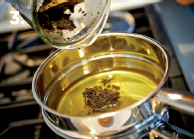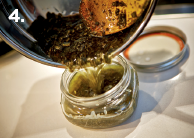
Comfrey
Comfrey is a member of the borage family (Boraginaceae), which also includes forget-me-nots. It is a large plant with broad, hairy leaves and purplish, blue, or white flowers. Native to Europe, it has long been cultivated for its remarkable healing properties and for use as an organic fertilizer. Its Latin name, Symphytum, is derived from the Greek symphyo, meaning to “grow together,” and its folk names include bruisewort, boneset, and knitbone. Many herbal preparations now use a cultivar called Russian comfrey (Symphytum × uplandicum), which is a hybrid of common comfrey (S. officinale) and rough comfrey (S. asperum).
 Health Benefits
Health Benefits
Comfrey is nature’s answer to the Band-Aid. In the past, its leaves were sterilized in boiling water and applied directly to wounds to reduce swelling and bruising, and even to promote rapid healing of broken bones. Comfrey’s ability to help heal wounds comes from a compound called allantoin (present in both the leaves and roots), which is believed to reduce inflammation and promote new cell growth.
Modern science seems to back up traditional beliefs. In one study, for example, a 35% comfrey cream applied topically to ankle sprains was very effective at treating tenderness, swelling, and pain even when compared with anti-inflammatory pharmaceutical creams.
In the past, comfrey was taken orally for gastrointestinal, respiratory, and gynecological concerns; however, it is now known that the plant contains toxic compounds, and it is listed as “topical use only” in herbal and medical textbooks.
DIFFICULTY
Easy
HARDINESS
Perennial in zones 4 to 9
TIME TO PLANT
Sow seeds directly into garden in early spring or purchase transplants in mid-spring
TIME TO HARVEST
Flowers in early to midsummer, roots in fall
LOCATION
Full to part sun
SOIL TYPE
Most (will grow in clay)
 Growing
Growing
Comfrey is a hardy perennial that is extremely easy to grow: its vigorous roots will even break through clay. It blooms throughout the summer and spreads rapidly, so it will thrive in most gardens. But a word of warning: comfrey is a big plant that will easily grow ½ to 1½ metre (2 to 5 feet) tall and wide and can take over its location.
Common Varieties: Common comfrey (Symphytum officinale) and the hybrid Russian comfrey are the most common; Red Comfrey (‘Rubrum’) is a cultivar that tolerates shade.
PLANT
Comfrey should be located in the middle or at the rear of a garden, since this large plant has been known to shade out its neighbours. Comfrey is propagated from seed, root cuttings, crown divisions, and transplants. Plant it in mid-spring after the risk of hard frost, or directly sow seeds in the ground in early spring, as soon as soil is workable. Divide plants in early spring or early fall. For best results, locate common comfrey in full sun, in rich, well-drained soil, and space 30 to 60 cm (1 to 2 feet) apart.
GROW
The biggest challenge with growing comfrey is getting it established; after that it will take care of itself. Water deeply and infrequently, ensuring new transplants never dry out. Regular applications of general-purpose water-soluble fertilizer (20-20-20) or compost tea (page 175) will also help.
Once established (give it about a year), comfrey is extremely winter-hardy, drought-resistant, and unlikely to be bothered by diseases or insects, but inspect it occasionally and remove any brown side shoots as necessary. Ensure adequate airflow by not overplanting.
HARVEST
Harvest mature plants only: Wait for a plant height of at least 60 cm (2 feet) before cutting leaves. Harvest during mid-morning on a sunny day after the dew has dried. Wear gloves, as the plant’s hairy leaves have been known to cause rashes.
Remove entire stalks by cutting to just above the base of the plant. You should not harvest more than a third of the plant at a time, but comfrey is an incredibly tough plant that will bounce back even after aggressive harvesting. In fact, it will produce additional growth and can be harvested up to 3 times per season.
STORE
Dry the stalks and leaves by hanging them upside down in a dry place out of direct light (see “Drying Herbs at Home” on page 365). Comfrey has dense foliage and will take longer to dry than other herbs. After drying, store the foliage in airtight containers out of direct light.

 Put It to Work
Put It to Work
Breastfeeding blues? Comfrey brings re-leaf!
The soothing demulcent properties of comfrey leaves can help relieve sore nipples after breastfeeding. Demulcents are traditionally used to aid healing and soothe irritated tissue.
To prepare a poultice, dip 2 fresh comfrey leaves into a mug of boiling water. Lay them flat on a clean surface and allow to cool. While they are still wet, wrap each leaf in a layer of gauze. Apply to the nipples for instant comfort and relief. Holding a heating pad or hot water bottle over the application will keep the poultice warm and active longer. Leave on for up to 15 minutes.
Before the baby breastfeeds again, the area should be rinsed thoroughly to remove any herbal residue.
IMPORTANT: Women planning to use herbs during pregnancy or breastfeeding should always seek the supervision of a qualified healthcare practitioner.
Joint or muscle trauma? Rub on some relief!
Comfrey cream should be in everyone’s first-aid kit. It can bring comfort to aching arthritic joints and sore muscles without the strong smell of most topicals—and it’s easy to make your own!
10 fresh comfrey leaves
¼ cup coconut oil
75 grams (5 tbsp) beeswax
In a blender, purée the comfrey leaves with enough water to make a thick paste. In a small heatproof bowl over a pot of boiling water (acting as a double boiler), melt the coconut oil and beeswax, stirring occasionally (1, 2). Add the puréed comfrey and mix thoroughly (3). Transfer the mixture to a small glass jar with a tight-fitting lid (4). Once the cream has cooled and solidified, apply it liberally to the affected area. The cream will keep in a cool, dry place for up to a year.





Roll an ankle? Sit down and get comfrey!
You don’t have to be an athlete or weekend warrior to sprain an ankle—just walking over a curb or an uneven surface can end up in a painful ankle roll. It is always best to start treatment for this type of injury with ice, but after several minutes it’s time to slip into something a bit more “comfrey.” This poultice will work on more than just a sprained ankle: apply to any sprained, strained, bruised, or battered body part.
Collect about 20 fresh comfrey leaves. In a food processor, chop the leaves and add enough water to make a thick soup. Transfer the mixture to a bowl and add enough psyllium husk (unflavoured Metamucil) to make a thick and sticky “porridge.”
Divide the mixture in half and spoon equal amounts into an old pair of socks. Flatten the poultice within the socks and seal the tops using elastic bands. Apply the socks to both sides of your hurt ankle and cover with plastic wrap to hold the socks in place and prevent leaking. Leave on for 15 minutes. Do not reapply more than hourly, and no more than 4 times in a day.
 Fast Forward
Fast Forward
Fast forward to the health food store to purchase Gaia Herbs Comfrey Compound or equivalent. Follow the instructions on the label.
 Cautions
Cautions
Many countries, including Canada and the United States, have banned oral medicines containing comfrey. Comfrey (especially the roots) contains potentially dangerous pyrrolizidine alkaloids. Avoid ingesting comfrey, as these compounds are toxic to the liver.
Just as with calendula cream, do not use comfrey on deep, puncture-type wounds, as it can cause the skin to heal over and seal infection inside.
Comfrey should also be avoided if you are allergic or hypersensitive to any member of the borage family (Boraginaceae). If you have never used comfrey it may be prudent to first test your sensitivity by firmly rubbing a leaf on the skin of your inner wrist. If a rash or irritation appears immediately or within a few hours, discontinue.